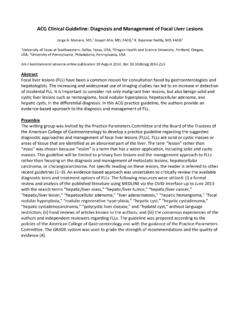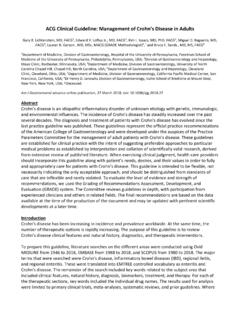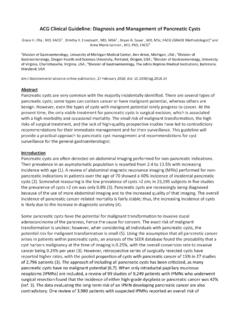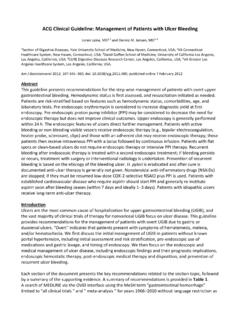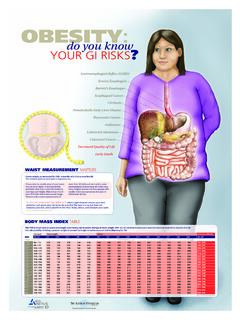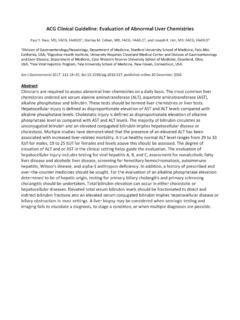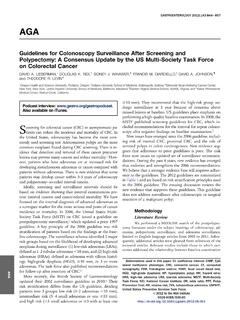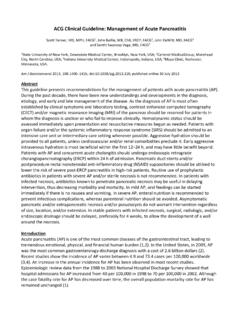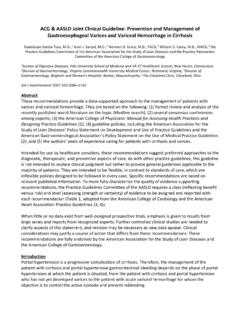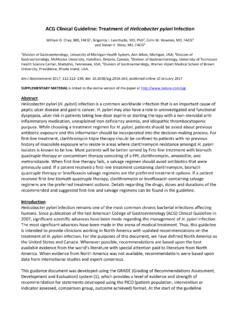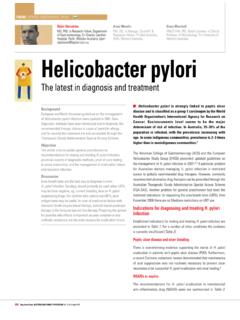Transcription of ACG Clinical Guideline: Diagnosis and Management of ...
1 ACG Clinical Guideline: Diagnosis and Management of Barrett's Esophagus Nicholas J. Shaheen, MD, MPH, FACG1, Gary W. Falk, MD, MS, FACG2, Prasad G. Iyer, MD, MSc, FACG3 and Lauren Gerson, MD, MSc, FACG4. 1. Division of Gastroenterology and Hepatology, University of North Carolina at Chapel Hill, Chapel Hill, North Carolina, USA; 2 Division of Gastroenterology, University of Pennsylvania Perelman School of Medicine, Philadelphia, Pennsylvania, USA; 3 Division of Gastroenterology and Hepatology, Mayo Clinic Minnesota, Rochester, Minnesota, USA; 4 Division of Gastroenterology, California Paci c Medical Center and Department of Medicine, University of California, San Francisco, San Francisco, California, USA.
2 Am J Gastroenterol advance online publication, 3 November 2015; Abstract Barrett's esophagus (BE) is among the most common conditions encountered by the gastroenterologist. In this document, the American College of Gastroenterology updates its guidance for the best practices in caring for these patients. These guidelines continue to endorse screening of high-risk patients for BE; however, routine screening is limited to men with re ux symptoms and multiple other risk factors. Acknowledging recent data on the low risk of malignant progression in patients with nondysplastic BE, endoscopic surveillance intervals are attenuated in this population.
3 Patients with nondysplastic BE should undergo endoscopic surveillance no more frequently than every 3 5 years. Neither routine use of biomarker panels nor advanced endoscopic imaging techniques (beyond high-de nition endoscopy) is recommended at this time. Endoscopic ablative therapy is recommended for patients with BE and high-grade dysplasia, as well as T1a esophageal adenocarcinoma. Based on recent level 1 evidence, endoscopic ablative therapy is also recommended for patients with BE and low-grade dysplasia, although endoscopic surveillance continues to be an acceptable alternative.
4 Given the relatively common recurrence of BE after ablation, we suggest postablation endoscopic surveillance intervals. Although many of the recommendations provided are based on weak evidence or expert opinion, this document provides a pragmatic framework for the care of the patient with BE. Introduction Recent population studies suggest that gastroesophageal reflux disease (GERD) is increasing in prevalence, both in the United States and worldwide (1,2). The Diagnosis of GERD is associated with a 10 15% risk of Barrett's esophagus (BE), a change of the normal squamous epithelium of the distal esophagus to a columnar-lined intestinal metaplasia (IM).
5 Risk factors associated with the development of BE include long-standing GERD, male gender, central obesity (3), and age over 50 years (4,5). The goal of a screening and surveillance program for BE is to identify individuals at risk for progression to esophageal adenocarcinoma (EAC), a malignancy that has been increasing in incidence since the 1970s (6,7). The purpose of this guideline is to review the definition and epidemiology of BE, available screening modalities for BE detection, rationale and methods for surveillance, and available treatment modalities including medical, endoscopic, and surgical techniques.
6 In order to evaluate the level of evidence and strength of recommendations, we used the GRADE (Grading of Recommendations Assessment, Development and Evaluation) system (8). The level of evidence ranged from high (implying that further research was unlikely to change the authors' confidence in the estimate of the effect) to moderate (further research would be likely to have an impact on the confidence in the estimate of effect) to low (further research would be expected to have an important impact on the confidence in the estimate of the effect and would be likely to change the estimate) or very low (any estimate of effect is very uncertain).
7 The strength of a recommendation was graded as strong when the desirable effects of an intervention clearly outweighed the undesirable effects and as conditional when there was uncertainty about the tradeoffs. We used meta-analyses or systematic reviews when available, followed by Clinical trials and cohort and case-control studies. In order to determine the level of evidence, we entered data from the papers of highest evidence into the GRADE program (accessible at ). For each recommendation, a GRADE table was constructed, and the evidence rated. Recommendation statements were structured in the PICO format (patient population involved, intervention or Indicator assessed, comparison group, and patient-relevant outcome achieved) when possible.
8 The aggregate recommendation statements are in Table 1. As part of this guideline preparation, a literature search was conducted using Ovid MEDLINE from 1946. to present, EMBASE 1988 to present, and SCOPUS from 1980 to present using major search terms and subheadings including Barrett esophagus, Barrett oesophagus, epithelium, goblet cells, . metaplasia , dysplasia, precancerous conditions, adenocarcinoma, radio- frequency, . catheter ablation, early detection of cancer, mass screening, and/or esophagoscopy, The full literature search strategy is demonstrated in Supplementary Appendix 1 online.
9 Table 1. Recommendation statements Diagnosis of BE. 1. BE should be diagnosed when there is extension of salmon-colored mucosa into the tubular esophagus extending 1 cm proximal to the gastroesopha- geal junction with biopsy con rmation of IM (strong recommendation, low level of evidence). 2. Endoscopic biopsy should not be performed in the presence of a normal Z line or a Z line with <1. cm of variability (strong recommendation, low level of evidence). 3. In the presence of BE, the endoscopist should describe the extent of metaplastic change including circumferential and maximal segment length using the Prague classi cation (conditional recommendation, low level of evidence).
10 4. The location of the diaphragmatic hiatus, gastroesophageal junction, and squamocolumnar junction should be reported in the endoscopy report (condi- tional recommendation, low level of evidence). 5. In patients with suspected BE, at least 8 random biopsies should be obtained to maximize the yield of IM on histology. In patients with short (1 2 cm) segments of suspected BE in whom 8. biopsies are unattainable, at least 4 biopsies per cm of circumferential BE, and one biopsy per cm in tongues of BE, should be taken (conditional recommendation, low level of evidence). 6. In patients with suspected BE and lack of IM on histology, a repeat endoscopy should be considered in 1 2 years of time to rule out BE (conditional recommendation, very low level of evidence).
